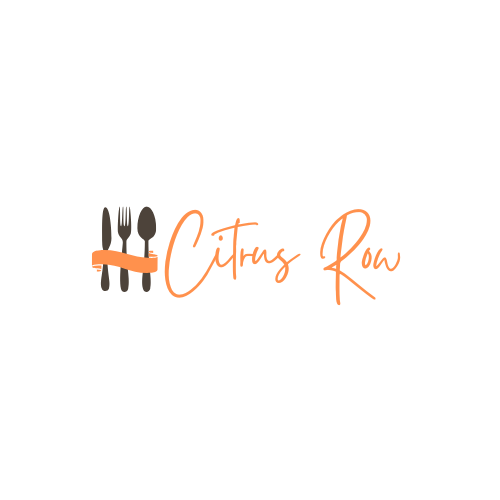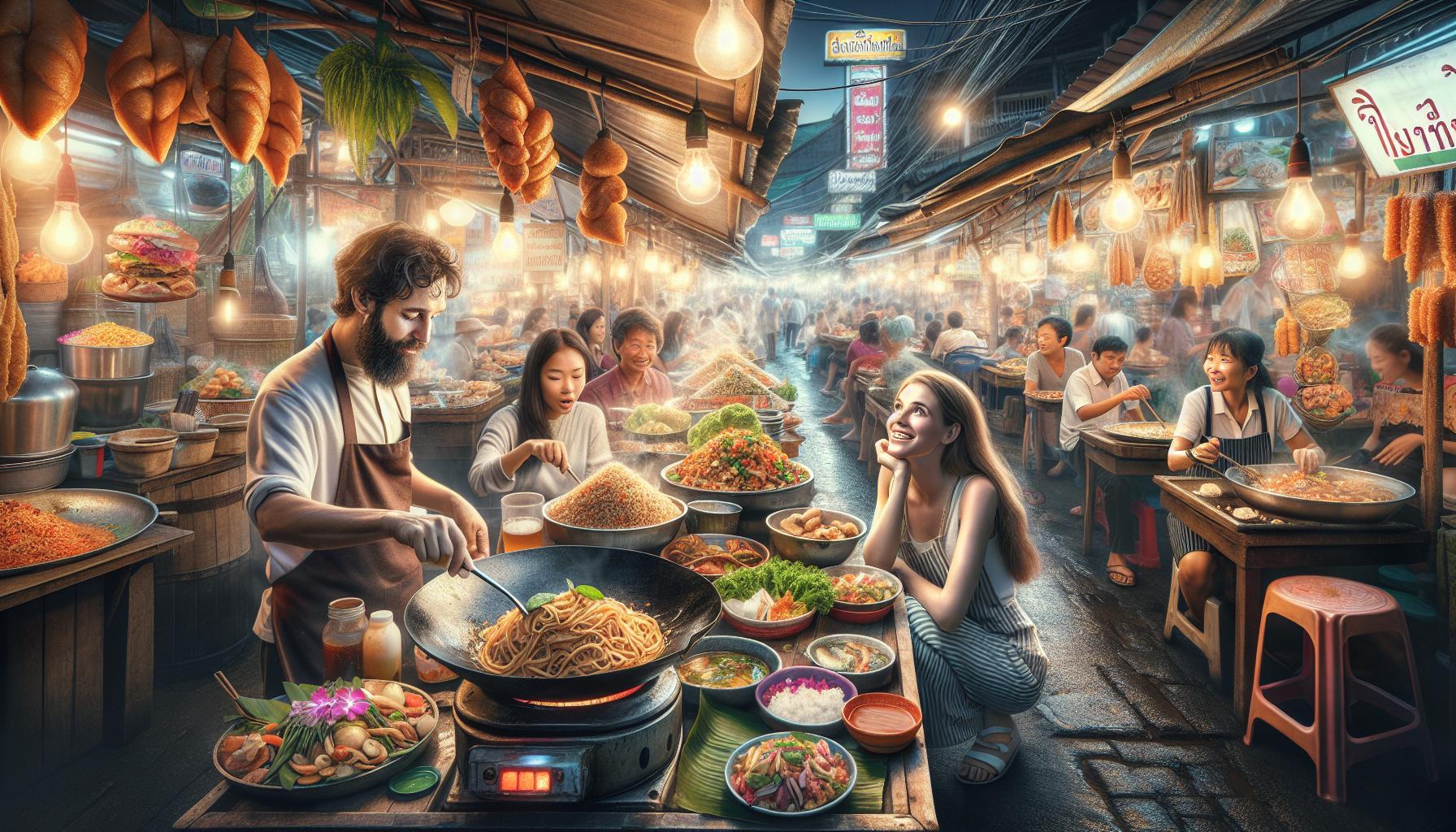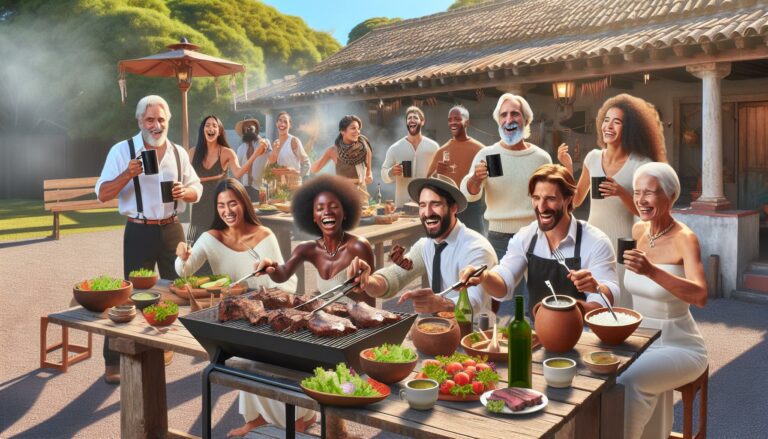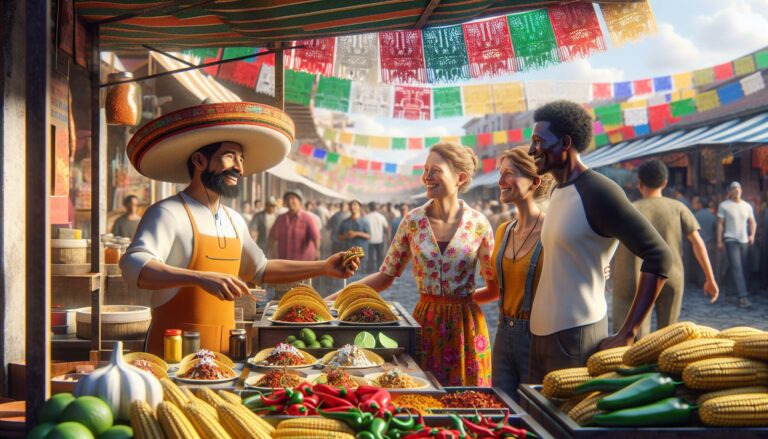Thai cuisine captivates food lovers worldwide with its perfect balance of sweet, sour, spicy and salty flavors. From bustling street food markets to traditional family kitchens Thailand’s food culture tells a vibrant story of tradition heritage and community.
What makes Thai food truly special isn’t just the exotic ingredients or complex cooking techniques – it’s the way food brings people together. Thai meals are traditionally shared experiences where multiple dishes grace the table family-style. You’ll rarely see a Thai person eating alone. Instead they embrace the concept of “gin khao” which literally means “eating rice” but represents the entire social dining experience.
The importance of food in Thai society runs so deep that the common greeting “gin khao yung” (have you eaten yet?) reflects how meals are woven into the fabric of daily life. This rich culinary heritage has earned Thai cuisine its place among the world’s most beloved food cultures.
The Heart of Thai Cuisine: Regional Diversity
Thai cuisine reflects distinct regional variations shaped by geography, climate local ingredients. Each region showcases unique culinary traditions influenced by neighboring countries cultural exchanges.
Northern Thai Specialties
Northern Thai cuisine features milder flavors influenced by Myanmar Burma Laos. Sticky rice serves as the staple accompaniment to signature dishes like khao soi (curry noodle soup) nam prik num (roasted chili dip). Traditional cooking methods incorporate seasonal herbs mountain vegetables such as wild mushrooms bamboo shoots. Dishes often include pork game meats served with dipping sauces made from tomatoes chilies garlic. The cooler climate supports growing ingredients like ginger turmeric that add earthy notes to regional specialties.
Southern Thai Flavors
Southern Thai cooking embraces intense spicy flavors abundant seafood from coastal areas. Fresh turmeric kaffir lime leaves shape distinctive yellow curries like gaeng som (sour curry). Coconut milk features prominently in dishes such as massaman curry traditional desserts. Local ingredients include fresh fish prawns sataw beans stink beans. Muslim influences appear in dishes like khao mok gai (Thai biryani) roti accompaniments reflecting the region’s cultural diversity.
Central and Eastern Influences
Central Thai cuisine represents the royal culinary heritage refined cooking techniques. Bangkok’s position as a trading hub introduced Chinese European influences into dishes like pad thai rad na. Eastern Thailand combines sweet sour flavors in preparations featuring tropical fruits seafood. Signature dishes include som tam (green papaya salad) grilled chicken with sticky rice. Fresh herbs vegetables from fertile farmlands enhance stir-fries curries served throughout these regions.
Essential Thai Ingredients and Cooking Methods
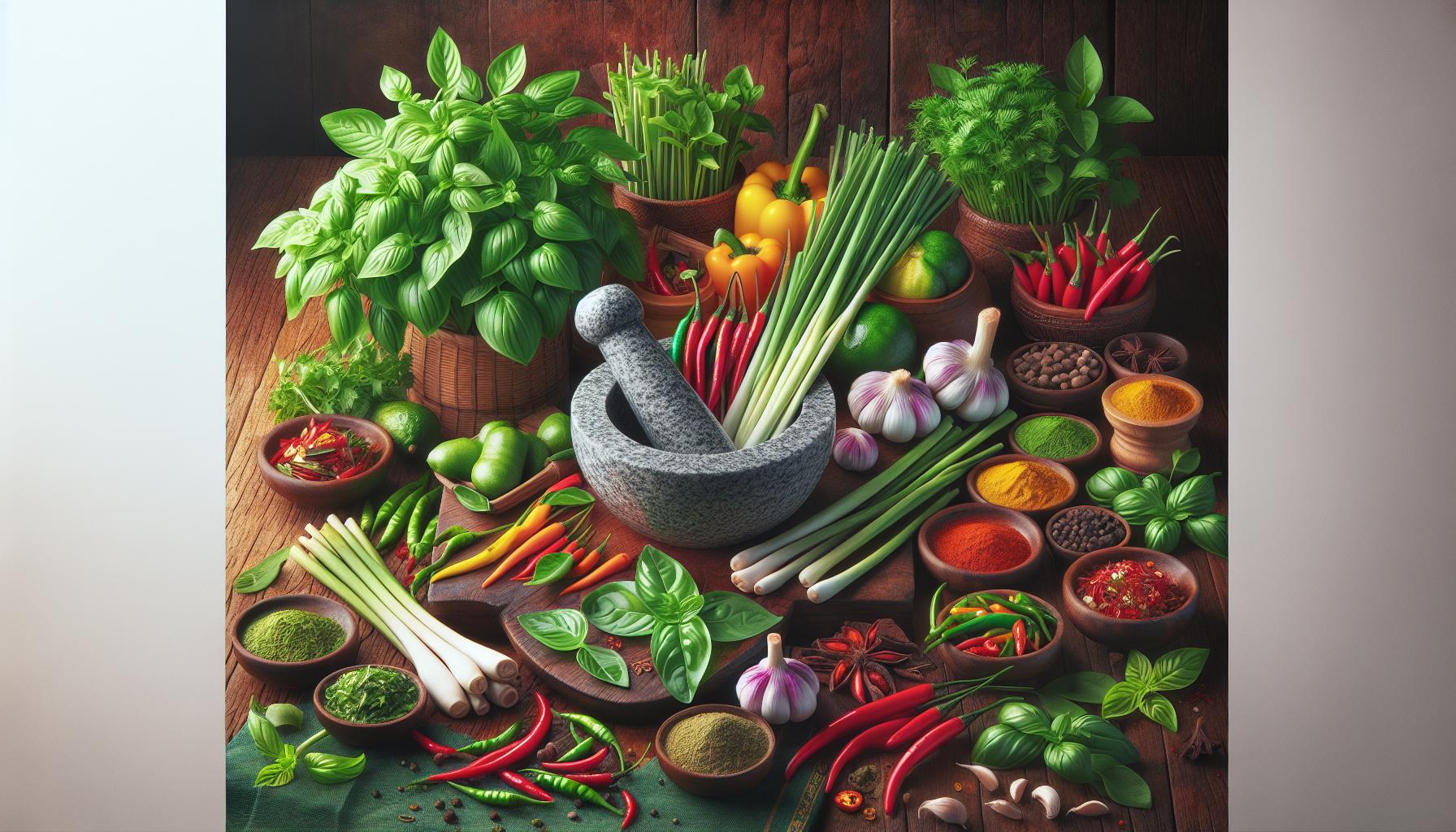
Thai cuisine relies on fresh ingredients combined with precise cooking techniques to create its distinctive flavors. The interplay of aromatic herbs spices with traditional cooking methods forms the foundation of authentic Thai dishes.
Traditional Herbs and Spices
Thai kitchens incorporate lemongrass kaffir lime leaves galangal ginger as foundational aromatics. Fresh Thai basil comes in three varieties: sweet basil (horapha) holy basil (kaphrao) lemon basil (maenglak). Garlic shallots cilantro roots provide depth to curry pastes stir-fries. Essential dried spices include white peppercorns coriander seeds cumin turmeric cardamom cinnamon. Fish sauce (nam pla) adds umami while palm sugar balances flavors in dishes. Chili peppers range from mild to extremely hot with bird’s eye chilies (prik kee noo) being the most common.
Cooking Techniques and Tools
Traditional Thai cooking employs wok frying steaming grilling pounding. The granite mortar pestle (khrok) creates curry pastes grinds spices makes papaya salad. Sticky rice requires specialized bamboo baskets steamers for proper preparation. Clay pots (moh din) slow-cook curries soups retain heat distribute flavors evenly. The wok (krata) handles high-heat cooking for stir-fries deep-frying. Coconut graters (krating) extract fresh coconut meat milk essential for curries desserts. Modern Thai kitchens combine these traditional tools with electric rice cookers food processors while maintaining authentic cooking methods.
Thai Dining Customs and Etiquette
Thai dining customs emphasize communal harmony and respect. These traditions shape mealtime interactions and reflect Thailand’s deep-rooted social values.
Family-Style Dining Traditions
Thai meals center around sharing multiple dishes placed at the center of the table. Diners receive individual plates of rice with small portions of shared dishes taken throughout the meal. The eldest family member starts the meal first, followed by others in age order. Common shared dishes include:
- Tom yum served in a central heated pot
- Stir-fried vegetables on communal plates
- Curry dishes in family-sized portions
- Platters of grilled meats or seafood
- Fresh herb garnishes for everyone’s use
A typical Thai table setting includes individual soup spoons paired with forks for serving. Chopsticks appear only with noodle dishes or Chinese-influenced meals.
Proper Table Manners
Thai dining etiquette follows specific cultural protocols:
- Using spoons as primary utensils with forks pushing food onto them
- Taking small portions to avoid waste
- Keeping elbows off the table during meals
- Passing dishes with both hands to show respect
- Waiting for elders to begin eating first
Table manners include:
| Do | Don’t |
|---|---|
| Eat rice with a spoon | Point feet at others |
| Leave a bite of food | Stick chopsticks vertically in rice |
| Finish rice in the bowl | Lick utensils |
The host serves rice first, followed by shared dishes. Conversations remain pleasant with quiet eating sounds.
The Role of Religion in Thai Food Culture
Religious beliefs shape Thai culinary traditions with Buddhism playing a central role in dietary practices. The connection between spirituality and food reflects Thailand’s cultural heritage through both Buddhist principles and royal customs.
Buddhist Influences
Buddhism influences Thai food culture through vegetarian practices observed during festivals like the Nine Emperor Gods Festival. Monks’ daily alms rounds, known as “Tak Bat,” create a sacred bond between laypeople and monastics through food offerings. Buddhist teachings promote mindful eating practices, encouraging moderation and gratitude during meals. The practice of making merit through food donations to temples remains an essential aspect of Thai spiritual life. Buddhist principles discourage waste, leading to creative use of ingredients and minimal food disposal in Thai cooking.
Royal Thai Cuisine Heritage
Royal Thai cuisine emerged from ancient palace kitchens, establishing elaborate cooking techniques and presentation standards. The royal courts developed intricate fruit and vegetable carvings called “kae sa luk” to elevate dining aesthetics. Palace chefs created sophisticated recipes using rare ingredients and complex preparation methods to serve the monarchy. These royal culinary traditions influenced modern Thai restaurant practices through detailed garnishing and multi-course serving styles. The preservation of royal recipes continues through specialized cooking schools and prestigious establishments in Bangkok.
Street Food Culture in Thailand
Street food forms the backbone of Thailand’s culinary landscape, offering affordable authentic dishes served from mobile carts, makeshift stalls, and small shophouses. These street-level establishments serve as social hubs where locals and tourists experience the vibrant flavors of Thai cuisine.
Popular Street Food Dishes
Thai street vendors specialize in signature dishes that showcase the country’s diverse culinary traditions. Pad thai combines stir-fried rice noodles with dried shrimp, tofu, eggs, tamarind sauce, and crushed peanuts. Som tam features shredded green papaya pounded with chilies, lime juice, fish sauce, palm sugar, and tomatoes. Moo ping presents grilled marinated pork skewers served with sticky rice. Khao man gai offers poached chicken with fragrant rice cooked in chicken broth. Roti transforms crispy pan-fried flatbread into both sweet and savory variations. Boat noodles deliver rich pork or beef broth with rice noodles, morning glory, and meatballs in small portions.
Night Markets and Food Stalls
Night markets emerge as bustling food destinations across Thailand after sunset. Ratchada Train Night Market in Bangkok features over 200 food stalls serving local specialties. Chiang Mai’s Sunday Walking Street hosts vendors offering northern Thai delicacies. Food stalls cluster in designated zones called “hawker centers” providing specialized dishes. Mobile food carts navigate busy streets during peak meal times. Vendors maintain consistent locations creating neighborhood institutions. Modern food courts incorporate traditional street food stalls in air-conditioned settings. Digital payment systems modernize transactions while preserving authentic cooking methods.
Modern Thai Food Culture
Thai cuisine continues to evolve in the 21st century, blending traditional practices with contemporary influences. Globalization shapes the modern Thai food scene while maintaining its cultural authenticity.
International Influences
Global ingredients enhance traditional Thai recipes through fusion techniques. Korean gochujang adds depth to som tum variations while Japanese ingredients like ponzu complement Thai seafood dishes. International restaurant chains incorporate Thai flavors into their menus, creating crossover dishes like tom yum pizza or pad thai burritos. Social media platforms showcase innovative Thai dishes, generating viral food trends like charcoal-infused coconut ice cream or rainbow-colored mango sticky rice. Modern Thai chefs experiment with molecular gastronomy techniques to present classic flavors in new forms, such as tom yum foam or green curry spherification.
Preservation of Traditional Methods
Thai culinary schools maintain authentic cooking techniques through structured certification programs. The Thai government protects traditional recipes by registering them as cultural heritage items, including tom yum goong national standard recipes. Local communities organize cooking workshops to pass down ancestral knowledge to younger generations. Professional Thai chefs document traditional methods through cookbooks video tutorials social media channels. Markets continue to sell traditional cooking tools like clay mortars granite pestles bamboo steamers alongside modern equipment. Family-owned restaurants preserve regional recipes by using locally sourced ingredients maintaining original preparation methods. Digital platforms archive traditional cooking techniques through detailed documentation photography video content.
Conclusion
Thai cuisine stands as a testament to the country’s rich cultural heritage blending centuries-old traditions with modern innovations. The interplay of regional flavors street food culture and royal influences has created a culinary landscape that’s both diverse and dynamic.
From bustling night markets to family dinner tables Thai food continues to evolve while maintaining its authentic roots. As Thailand embraces the future its food culture serves as a bridge between generations preserving traditional methods while welcoming contemporary influences.
This harmonious balance between old and new ensures that Thai cuisine will continue to captivate food lovers worldwide while staying true to its cultural essence.
